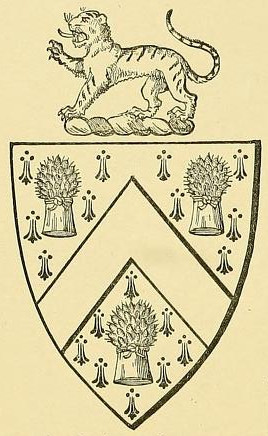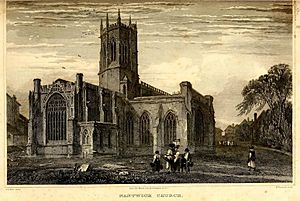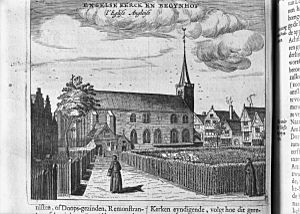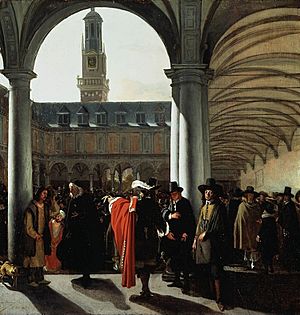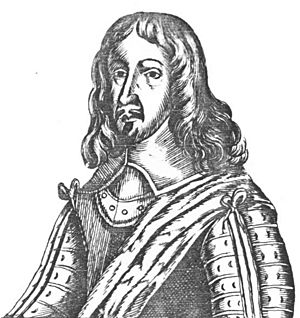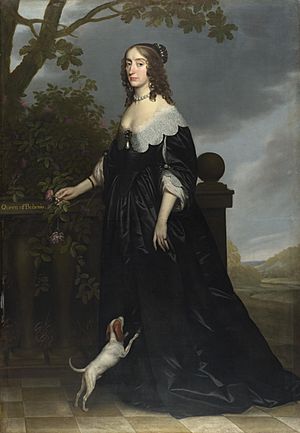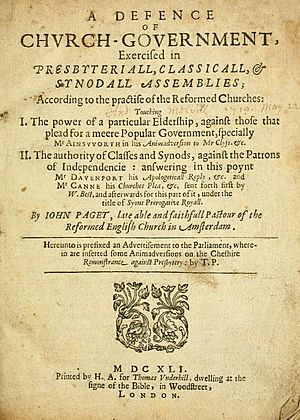Briget Paget facts for kids
Quick facts for kids
Briget Paget
|
|
|---|---|
| Born |
Briget Masterson
1570 Nantwich, England
|
| Died | circa 1647 Dordrecht, Netherlands
|
| Nationality | English |
| Occupation | Editor |
| Years active | 1638–41 |
| Known for | Editing and one dedication to posthumous publications of John Paget |
|
Notable work
|
Work on Meditations of Death, A Defence Of Church-Government, Exercised in Presbyteriall, Classicall, & Synodall Assemblies. |
| Spouse(s) | 1. George Thrushe (–1601) 2. John Paget (1602–1638) |
| Parent(s) | Richard Masterson Elizabeth Grosvenor |
Briget Paget (born Masterson, 1570–around 1647) was an English Puritan woman. She was important because she managed and edited the writings of her husband, John Paget, after he passed away.
Contents
Early Life and Family
Briget Masterson was born in 1570. Her family was well-known and wealthy in Nantwich, England.
Her parents were:
- Richard Masterson (who died in 1617)
- Elizabeth Grosvenor (who died in 1627)
The Mastersons were one of the oldest and most important merchant families in Nantwich. This means they were powerful business people in the town. Briget's father, Richard, became quite rich and gained a higher social standing. This was partly because he married Elizabeth Grosvenor, whose family was part of the landed gentry. This meant they owned a lot of land.
Briget grew up in a very comfortable home called Presthume. It was a large property with a mill and a dovecote, surrounded by over 200 acres of land. Her later writings show that she was likely well-educated and could read and write.
Marriage and Moving Abroad
Briget Masterson first married George Thrushe, who sadly died in 1601. Soon after, on February 8, 1602, she married John Paget in St Mary's Church, Nantwich.
John Paget was the church leader (Rector) of Nantwich. He was a Puritan, meaning he wanted to make the Church of England simpler and more focused on the Bible. His strong beliefs were well-known.
However, a new king, James I, came to power. He made new rules for the Church of England that Puritans like John Paget found hard to follow. John Paget was one of many church leaders who refused to agree to these new rules. Because of this, he had to leave Nantwich in 1605.
John and Briget moved to the Dutch Republic (modern-day Netherlands). John first worked as a chaplain for English soldiers there. Then, in 1607, he became the minister of the new English Reformed Church, Amsterdam. The couple then settled and built a life in Amsterdam.
Life in Amsterdam
In Amsterdam, John Paget was very involved in religious discussions. He often argued against other groups of Calvinists (a type of Protestant) who he felt were too extreme. He also strongly supported the Protestant cause in Europe, especially Frederick V, Elector Palatine and his wife, Elizabeth Stuart, Queen of Bohemia. Elizabeth was the daughter of King James I of England. Both Frederick and Elizabeth attended services at John Paget's church in Amsterdam. Briget's later writings suggest she became quite close to Elizabeth.
The Pagets became quite wealthy in Amsterdam. They owned at least two houses and bought shares in the Dutch West India Company. This company was involved in trade and fighting against Catholic Spain and Portugal. Their investment showed their support for the Protestant cause.
Even though they were wealthy, the Pagets seemed to live simply, following their Calvinist beliefs. A visitor named Sir William Brereton visited them in 1634. He was impressed by the "neat dinner" and especially the strawberries they served, which were a new and rare fruit in Europe at the time. He also noted that John Paget earned a very good income from his church.
Briget Paget managed her own money and actively supported her husband's political and religious beliefs. She presented herself in a modest way, which was common for women at that time.
Widowhood and Legacy
Briget and John Paget did not have children of their own. They adopted John's nephew, Robert Paget, as their heir. They made sure he received a good education.
John Paget passed away on August 18, 1638. After his death, Briget moved to Dordrecht, where Robert had just become a church minister. John's brother, Thomas Paget, took over as minister at the English Reformed Church in Amsterdam.
Briget took on the important role of protecting and publishing her husband's writings. In 1639, she published Meditations of death, a collection of sermons that had not been published before. Briget wrote the dedication for this book herself, making it clear she was the editor. She dedicated it to Elizabeth of Bohemia, who was a symbol of the Protestant cause. Briget wrote about her own sadness after losing her husband and hinted at a close friendship with Elizabeth.
In 1641, Briget and Robert Paget published another of John's works, A defence of church-government. This book was about John Paget's arguments with other English religious groups in Amsterdam. The book was published at a very important time, as conflict was growing between King Charles I (Elizabeth's brother) and the Parliament in England. Thomas Paget, Briget's brother-in-law, wrote a special message to the English Parliament, presenting the book to them. He explained how John Paget's ideas were important for the Presbyterian cause.
Back in England, Briget's own family, the Mastersons, were caught up in the English Civil War. Most of them supported the King. Briget's nephew, Thomas Masterson, had his property taken away in 1644 because he supported the King. He had to pay a large fine to get it back. Briget's brother-in-law, Thomas, supported Parliament and returned to England around 1646. Briget herself never went back to England.
Later Years
Briget Paget sold two of her houses in Amsterdam in 1647. It is believed that she died in that year or shortly after. In her will, she left money and gifts to Robert Paget and her other nephews and nieces.
|


